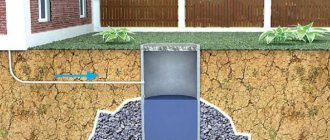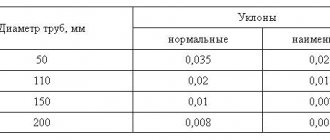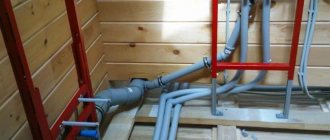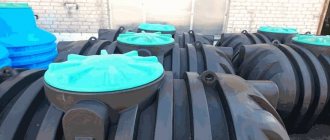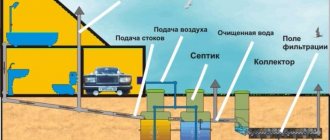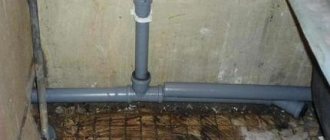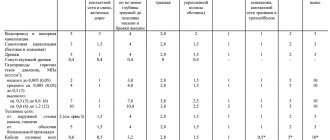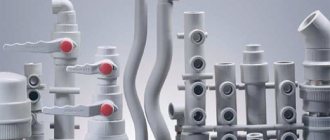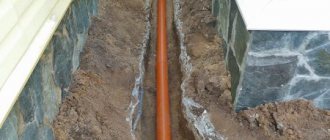When constructing a drainage system, it is necessary to comply with sanitary standards for the distance of the sewerage system from a private house. This is an important issue on which the comfort and health of people depends. It is relevant only for residents of the private sector who independently build an autonomous sewer system on their property.
All attempts to build “by eye” can lead to outbreaks of diseases, the appearance of a bad smell in the house and other undesirable phenomena. Any owner understands that containers should be located as far away as possible. However, the size of the site does not always allow the tank to be carried over a long distance. You need to know what the minimum values are, otherwise you will face penalties and unpleasant conversations with inspectors. Let's take a closer look at this issue.
What standards regulate the location of objects on the site of a private house?
The main document according to which the construction of a house and the installation of communications is carried out is the project. It contains a work plan indicating all distances and dimensions. The distance from the house to the sewer drainage point is also indicated here. During design, we are guided by two standards:
- SNiP 2.04.01-85;
- SanPiN 2.2.1/2.1.1.1200-03 (or 2.1.5.980-00).
These documents detail all the requirements for sewerage and define the minimum permissible distances between objects and buildings. It must be taken into account that instead of SNiP, the updated version of SP 30.13330.2016 is used today. It is more in line with current realities, although there are no fundamental differences. Regardless of where and by whom the sewerage system is built, the rules and regulations must be strictly followed.
Some owners of private houses believe that the location of the sewer system is their own business. This is a wrong point of view. The rules and regulations specified in building and health directives must be followed by everyone without exception. If the system is being built on the site of a country house, the requirements are more relaxed. But, for a residential building, all existing requirements must be met.
It is noteworthy that the issue of the distance from the septic tank to the house is ambiguous. While the minimum value is clearly defined, the maximum value is not mentioned anywhere. Sanitary standards for sewerage for the private sector also do not mention a maximum. It is only noted that it is advisable to make the distance as large as possible. However, if the septic tank is too far away, blockages or defrosting of the pipes are inevitable. Under such conditions, the system will not be able to operate normally. Therefore, the location of the sewerage system on the site must meet not only sanitary, but also operational requirements.
Installation of plastic pipes for heating
Visual installation diagram with description
The main problem that a home master solves when installing a new heating system: connecting plastic pipes to metal pipes. Industry responds:
- threaded connection fittings are available with cross-section up to 40 mm;
- from 40 to 300 mm – flanged.
The operating instructions are similar to connecting polypropylene pipes.
Conditions for placement of receiving tanks
It is best to install a cesspool, septic tank or other receiving device in an area with soft soil. It does not create difficulties when performing excavation work. However, the home owner does not have to choose. If there is a high groundwater level, it is necessary to ensure the maximum possible distance from the septic tank to buildings and drinking wells. This is important, since drainage may break into the ground.
When choosing a location for a septic tank, you should first consider the lowest points of the site. This will reduce the amount of excavation work. In addition, it will be easier to ensure the slope of the pipelines.
An important point is the possibility of access of special equipment. From time to time, the septic tank will have to be cleaned of accumulated waste.
If the sewer truck cannot fit, you will have to do the work manually.
When drawing up a plan for the placement of a septic tank, it is necessary to draw a drawing of the site to scale. It must indicate all buildings, structures, and communications. This will allow you to more correctly determine the optimal location for the septic tank.
You may also like:
Sewage pipelines made of high-density polyethylene pipes with sleeves with a diameter of 110 mm: technology and features
Slope of sewer pipes according to SNiP
Once again about the rules
- Products for installation must be free of mechanical damage (chips, cracks, dents are unacceptable).
- The fewer turns in the system, the more reliable the highway
- Be sure to ensure tight connections when making connections.
- It is forbidden to cut or shorten the bells
- The pipe cross-section is selected in accordance with the number of plumbing fixtures
- Horizontal pipes are laid at an angle
- The internal line should be fixed to the floor or wall
- Be sure to install ventilation
- Installation of "revisions" is necessary
- Installation of a riser with a horizontal pipe is prohibited at right angles
- Connection to plumbing is carried out with flexible hoses
- The external system should be insulated
- An inspection well is installed for every 15 meters of external sewerage.
If you follow all the rules for laying sewer pipes, the installation will be high-quality and durable.
Allowable distances
SNiP defines the minimum distance from structures to the foundation as 5 m. However, this requirement applies primarily to filtration wells or fields. The sealed receiving tank may be located closer to the house. But even in this case, there remains the danger of wastewater leaking into the ground. Pipe connections sometimes come apart. Mechanical loads or soil movements can destroy pipes. Therefore, you should not take risks and install the container close to the walls.
For cesspools, the distance must correspond to standard values. This is prescribed by sanitary standards for the sewage system of a private house. The tanks emit an unpleasant odor and the waste releases harmful gases. Failure to comply with the requirements may result in unbearable living conditions. In addition, there is a danger of the spread of infections and biogas poisoning.
In addition to the distance to home, it is important to meet other requirements. The location of the sewerage system on the site according to SNiP requires that:
- from the septic tank to the border of the site (neighbors’ fence) must be at least 2 m;
- the distance to the garden (planting area) should be 3 m or more;
- it is necessary to provide a distance of at least 30 m to the water intake site (well, drinking well). If the site has loose sandy soil, the norm increases to 50 m;
- to a river or stream - 10 m;
- the nearest body of water - at least 50 m;
- to the road (roadway) - 5 m.
The design standards for sewerage in a private house are primarily designed to ensure comfortable living for people. The second task is to preserve the structures of buildings. In addition, it is important to create normal conditions for plant growth and eliminate any influence of the external part of the system on neighbors. If violations are committed during the construction of the sewerage system, the owner will have to bear the appropriate punishment. This may be financial, administrative or even criminal liability. Ill-considered actions are fraught with undesirable consequences, so it is important to carefully follow all the requirements of regulatory documents.
When building an autonomous system in a private house, you will need to coordinate the project with the BTI. If this is not done, the construction will be considered illegal. When the presence of an unapproved structure is discovered, you will have to pay a fine and register the system. In some cases it may be forced to be demolished.
Replacing cast iron sewer pipes with plastic ones
In older houses, cast iron pipes were used in the bathroom and toilet. I would like to replace them with a modern analogue. It’s easy to handle, the main thing is to come to an agreement with the neighbors on the riser so that there are no incidents. Let's get started:
- They cut out the old riser: leave 10 cm at the top, 40 cm at the bottom. To make it easier, make several cuts with a small jumper, then knock them out with a sledgehammer. The main thing is not to damage the rest.
- The joints with the plastic are cleaned.
- Fastenings for the new riser are being prepared.
- The plastic is installed with the sockets facing up; work must begin from the bottom.
- After preliminary fitting, the plastic is installed and secured with clamps with rubber gaskets.
Now you know how to do wiring, installation of sewerage, heating, and water supply systems using modern materials. And also that a home handyman can do anything.
What to do if the area of the plot is too small
A standard plot does not always allow you to fully meet the requirements for sewerage in a private house. Various factors interfere:
- presence of outbuildings;
- difficult ground conditions;
- site configuration (narrow and long shape).
It is necessary to take into account that the installation of the drainage system must be carried out in accordance with all current regulations. If the characteristics of the site do not allow the construction of an autonomous sewer system, it is necessary to solve the issue by other methods. Possible options:
- sealed storage container. It does not communicate with the field or filtration well, so the danger of saturating the soil with wastewater is eliminated. However, you will have to constantly monitor the volume of drainage and periodically pump out. The option is quite dubious, especially for a residential building with permanent residence;
- local treatment plant. This is a complex that completely processes waste and does not require soil treatment. The design is quite complex and requires connection to a power supply.
The most reliable option is a local station. It is expensive and requires some care. But, if there are no other options, you have to use all available possibilities.
Fittings for sewerage
The sewer system implies the presence of a certain number of fittings, to determine which an accurate calculation of the project is necessary.
Installation of fittings is carried out according to certain rules and has some features:
- Fittings with an angle of 22.5, 45 and 90 degrees are equipped with sockets on both sides. Transition elbows usually have only one socket. Such fittings are often connected to regular fittings, which saves some space: two standard fittings connected by a pipe will take up more space (pro
Fastening drainage lines
The pipes are secured using special clamps. If plastic pipes are used to drain recycled water, it is necessary to place the fasteners evenly along the entire length of the device, approximately every 0.5-1 m.
To fasten risers with a diameter of 100-110 mm, steel brackets with a bend at the end are used, which prevents the pipeline from moving under water pressure.
Brackets must be placed under each outlet pipe near the socket.
The correct placement of brackets on the sewer riser can be seen in the figure:
Placing brackets on a sewer riser
To secure the riser to the side walls, 1-2 clamps are used per floor of the building.
Is it necessary to install liners?
The need to install a sleeve for the passage of pipes passing through walls is dictated by the requirements of SNIP. They are due to the following reasons.
- The polymer pipeline changes its dimensions due to the influence of temperature. In addition to expansion, it can move. To prevent deformation and create the necessary free space, SNIP recommends using sleeves. These devices for passing pipes through walls and ceilings make it possible to maintain the integrity of the structure during installation activities and during significant temperature changes.
- SNIP also states that a device for passing pipes through walls and ceilings allows dismantling without destroying the structure.
- Installing protection for the passage of pipes through walls, ceilings or foundations becomes a barrier to the penetration of odors and insects from adjacent rooms.
In accordance with SNIP, sleeves are recommended to be installed only in certain cases. Their installation is not always considered advisable. Also, waterproof material for laying between pipe products is recommended in situations where the cartridge is laid through a passage unit through the ceiling.
General information
The construction of private houses is experiencing a real boom. For this reason, future owners of such buildings need to install a convenient sewer system, which even a non-specialist in this field can install. At the same time, the drains must be endowed with good performance, because many owners have significantly increased the number of connected plumbing fixtures. First of all, this is due to the availability of a variety of modern washing machines and dishwashers, and showers and Jacuzzis are gaining popularity. These devices increase the usual volume of water consumption by two hundred liters during the day.
The increase in the number of installed plumbing fixtures becomes the reason for the complication of the entire drainage system. Fortunately, to set up a good system, you can use PVC pipes, which come with additional fittings that allow you to assemble an engineering structure in a few days. In addition, plastic parts are sold together with O-rings, which can be easily replaced if a mechanical defect or other damage occurs.
The assembled internal drainage system consists of a large number of plastic pipes. As well as shaped elements intended for connecting main pipes. The entire engineering system is designed to drain wastewater from plumbing installed in a house or apartment. It is worth remembering that installation of sewer pipes in violation of established installation rules leads to disruption of proper operation and other unpleasant consequences.
